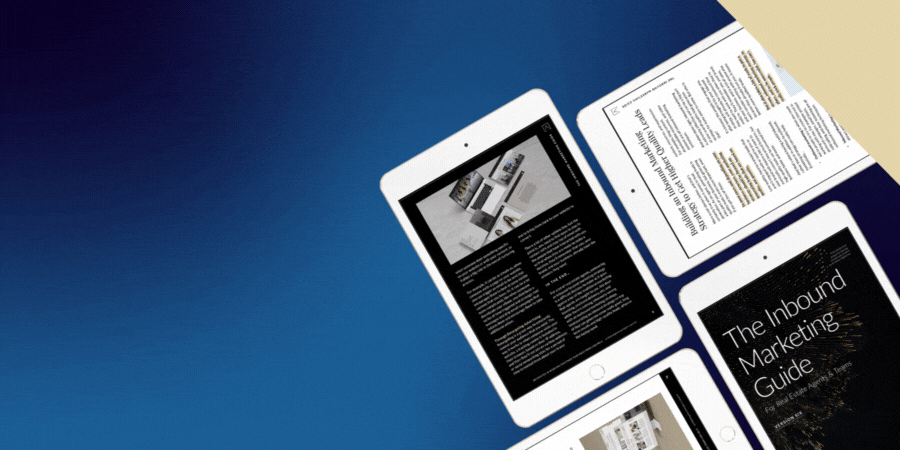A lot of real estate agents will say that the main objective of their marketing efforts is to “generate leads”; and while generating leads is obviously a big part of why you have a marketing strategy in the first place, to be successful, you have to break the concept of “generating leads’ down, as well as plan for what happens after you’ve received a lead.
The term “generating leads” is too general, at least from a marketing perspective.
For example, if you have gated real estate listing content on your website, and someone needs to fill in their email address to see the price, and you get notified they did that with their email address, is that a lead?
Most agents wouldn’t even know what to do with just an email address.
If you reached out them (just because they put in their email address to see a price), they’re probably going to think you’re too aggressive (and maybe even a little but creepy) rather than helpful. Instead, it’s better to have, as part of your inbound marketing strategy, a solid stickiness strategy in place, and allow those people to reach out again when they’re ready, not when you are.
Stickiness ensures that they’ll continually be reminded that you and your business exist, with the goal that when they’re ready to make a real estate decision, they’ll reach out because they remember you.
A better approach to take is, rather than generating leads, to generate contacts, ie: real, identifiable people who are discovering you for the first time, and then making sure they remember you afterwards.
There’s obviously a lot more to it, but here’s how it works:
★ The first step is to determine what a “lead” actually means to you. To learn more about that, have a look at this post right here.
As part of your real estate marketing strategy, you have 2 main goals:
- Your Discovery Strategy: Helping people discover you, your brand, and your business, for the first time.
- Your Stickiness Strategy: Ensuring they remember that you exist after they initially discover you for the first time.
Your Discovery Strategy:
Your discovery strategy is the first part of your marketing strategy; it’s the way that someone first discovers you, your brand, or your business.
Obviously, that can happen in a lot of different ways, like:
- They could find your website, organically, as part of a Google search.
- They could do a Google search, and click one of your PPC ads.
- They could get your monthly printed postcard in their mailbox.
- They could be told about you by someone that’s worked with you before.
- Or a ton of other different ways.
As part of your stickiness strategy, which way they first discover you isn’t really important, as long as they do (although I’d argue that them discovering you digitally is better for tracking purposes). What is important though, is the initial impression you make on them through the way they’ve discovered you, as you’ll obviously want that to be a positive experience.
Once they’ve discovered, it’s time for you to continually remind them that you exist through your stickiness strategy.
★ Want to learn more about building a discovery strategy? Have a look at these posts:
- Building a Marketing Discoverability Strategy
- How to Launch a Successful Real Estate Marketing Campaign
- How to Build an Online Presence Strategy for Your Real Estate Brand
- Establishing a Pull/Push Marketing Strategy
- Building a Hyper Local Real Estate Marketing Strategy
Your Stickiness Strategy:
Your stickiness strategy is the second part of your marketing strategy; it’s how someone is continually reminded that you, your brand, and your business exist.
Because of the nature of marketing, it’s not always possible that when someone first discovers you, they’ll want to transact right away at that moment; but there’s a good chance they will at some point in the future, so your stickiness strategy is a key part of making sure that they’ll remember you when it’s time to make a decision about who to work with for their next real estate transaction.
Having a good real estate stickiness strategy means casting a wide marketing net and covering a lot of bases with your marketing efforts. Sure, your strategy could go all in on one effort, but if you choose multiple, then you’ll be creating multiple opportunities in multiple ways that someone will be reminded of you and your business, rather than it always happening in the same place.
For example, a good stickiness strategy, that covers a wide range of marketing, could include:
- A retargeting advertising strategy, where people continually see your ads on other websites after they’ve visited yours.
- An email marketing strategy, where people regularly receive value-based emails from you.
- A print marketing strategy, where people continually receive your monthly real estate market update postcard.
- A content strategy, where people consistently return to your website to read the interesting and engaging content you write.
- A social strategy, where people steadily see and engage with your posts, videos, and stories on various platforms.
- An automation strategy, where people are automatically sent the right information at the right time.
- Or any of the other near-limitless options…
You don’t need to do all of these to be successfully sticky, but the more sticky opportunities you create, the more opportunities you have to be remembered.
Make Them Choose You
Nowadays, it’s harder than ever to capture someone’s attention, and it’s even harder to keep it.
A solid stickiness strategy is one of the best ways to periodically capture someone’s attention and continually remind them you exist. If you don’t remind them, they’ll forget about you; and someone else will capitalize on those opportunities, and eventually, they’re likely to choose them instead of you.
Want to get better, more qualified leads and build your authority? Our Inbound Marketing Guide is a walkthrough of the overall philosophy of inbound marketing, why it’s effective, and how you can build it into your own real estate marketing strategy to get better marketing results.




